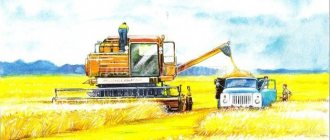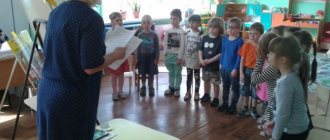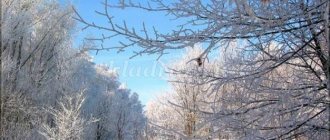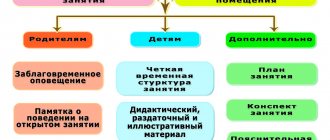Senior group. Senior preschool age. Children 5-6 years old
Summary of an open lesson on moral and patriotic education in the senior group “We are patriots of our Motherland” Purpose: To summarize and systematize children’s knowledge about Russia. Objectives: 1. Educational: to form a respectful attitude towards state symbols, to consolidate the names of large Russian cities and rivers, peoples inhabiting the Russian Federation; teach children to love their homeland, admire its beauty;...
Summary of an open lesson in the senior group “Customs and traditions of the Russian people”
MBDOU "Kolyvan kindergarten "Firefly"
Continuous educational activities on social and communicative development in the senior group Theme of the GCD:
“Customs and traditions of the Russian people
. Priority educational area: socio-communicative development. Integration with…
Summary of an open lesson in the senior group of the preschool educational institution “Blizzard Songs”
- December 5, 2019
International and All-Russian competitions
Winner of the All-Russian competition of pedagogical excellence “Methodological piggy bank of a kindergarten teacher”
Tasks:
• Educational: Arouse children's interest in such winter phenomena as blizzards, blizzards, blizzards, whirlwinds. To introduce how poets and composers reflected these phenomena in their work. • Educational: To foster an emotional experience of the unusual state of winter weather, the desire to correlate the perception of the picturesque landscape of a literary and musical work with one’s own experience. • Developmental: Develop responsiveness to poetic and musical images, empathy for them, the desire to complement your landscape drawing with what you hear and feel. Develop children's creativity and imagination. • Technical: Strengthen the skills of drawing with gouache using the method of 1) spraying; 2) foam rubber pokes; 3) a large, hard brush; 4) applying semolina to glue. • Speech: Develop the ability to form emotional and aesthetic judgments, assessments, and enrich children’s figurative speech. Introduce into active speech the concepts: blizzard, storm, blizzard, blizzard, whirlwind.
Material: white gouache, large hard cysts, pokes with foam rubber, toothbrushes, glue, semolina, recording of music: P.I. Tchaikovsky “February”; W.A. Mozart “Symphony No. 40”.
Preparatory work . Reading literary works about blizzards, blizzards, blizzards, blizzards. Excerpts from the story “Chuk and Gek” by A. Gaidar. Fairy tales: “The Snow Queen” by G.H. Andersen, “The Twelve Months” by S. Marshak and others. Observations on walks. Looking at illustrations.
Progress of an open lesson
Children sit on chairs on the carpet. The teacher draws attention to the bunny hidden under a white blanket.
Educator: Look, children, someone is hiding here, sitting, trembling. Let's see who it is? (Takes out the bunny). Children, who is this? Hush, don't scare him. Now I will find out from him why he is trembling so much. (Applies to ear).
Educator: He says that he was running through the forest, looking for something to eat, and a fox was on his trail and was about to find him and eat him. Let's help the bunny. Suggest how.
The teacher leads the children to the decision that the bunny can be sent to the forest that they drew. The forest is the bunny’s home, where he is used to living, and his traces can be covered with the help of a blizzard, whirlwind, blizzard, blizzard, blizzard.
Educator: The sorceress - the brush - will teach us all this. Now I'll call her:
Kribble-krabble-bis Fairy-tassel appears!
(Take out a brush).
Educator: Children, say hello to the fairy. (Look at it, put it on the stand). Listen to what the brush told me.
In winter there is different weather - both sunny and cloudy. But sometimes there are days when a strong wind blows, it lifts snow from the ground to the sky, and then nothing but this white veil is visible. People call this weather phenomenon a blizzard, whirlwind, blizzard, blizzard, blizzard. Animals in the forest in such weather look for a secluded place, somewhere under a snag or under the roots of a fallen tree, or in the bushes, and wait out such bad weather - snow and wind.
The winter month of February is very famous for blizzards, storms, and blizzards. Remember, in the fairy tale “The Twelve Months” he ordered the winds, storms, hurricanes to blow as hard as they could, and by nightfall to break out into whirlwinds, blizzards and blizzards. Whirl, smoke and whip up flying snow?
Fulfilling her order: Violent winds rose, Converged with hurricanes, In the fields, forests, playfully, Sang and whirled. (S. Drozhkin)
-What did the violent winds do? Here is another poem by I. Nikitin, listen:
The bad weather began to rustle and roam in the field Covered itself with white snow The smooth road; She covered herself with white snow, leaving no trace. Dust and a blizzard rose. There was no light to be seen.
– What happened to the trail on the road? And here is another poem by F. Shkulaev:
Flowing snow, like clouds, spread across the ground... The pines sang and made noise... The blizzard cried in the darkness...
-What was the blizzard doing? Do you know poems about a blizzard, a blizzard, a whirlwind, a blizzard? (Children recite poems).
With a light haze, invisible, the blizzard cleared up and hid with a blanket the Hills, valleys and meadows... (F. Shkulaev).
The blizzard, howling, sprinkles snow dust, sadly fills the soul; the winds are filled with a wild, menacing howl. (S. Frug).
The storm covers the sky with darkness; Whirling snow whirlwinds. Then she will howl like a beast, then she will cry like a child. (A. Pushkin).
Educator: Haze is when it’s hard to see.
The clouds are rushing, the clouds are swirling. The invisible moon illuminates the flying snow; The sky is cloudy, the night is cloudy. (A. Pushkin)
Educator: What were these poems talking about? Who heard and remembered what? (Children's answers).
Result: This is how poets reflect blizzards, blizzards, blizzards, and blizzards in their works.
And now the brush fairy invites you to imagine how these phenomena are reflected in music. Imagine what the music of P.I. Tchaikovsky “February” will tell you about. Close your eyes and listen to the piece.
♫ Listening to P.I. Tchaikovsky’s work “February”.
Educator: What did the music tell you? What did you present? (Children's answers). And now the magic brush wants to turn you into light, airy, wind-obedient snowflakes. Listen carefully to the music, it will tell you the movements.
They took out the ribbons from under the chairs and went out into the middle. Away from each other so as not to interfere.
(Remove the table with the bunny. Take the brush in your hands.)
Krible, krible jayu - I’m turning you into snowflakes!
Turn around yourself, now you are snowflakes.
♫ Physical school.
Educator: They fluttered like snowflakes. (Children perform different movements at will. At the end of the music, sit down.) And they lay down on the ground.
(Pays attention to the bunny. Pick it up.)
Educator: The bunny continues to tremble and is afraid that the fox will find him on the trail. Let's help him. You now know from poetry and music what a blizzard, blizzard, blizzard, blizzard is, let's draw it all. Place the ribbons on the table, take the chairs and place each one next to its own design. Turn them towards the board.
(Take a bunny and a brush with you. Children sit facing the board).
Educator: How well you and I drew each piece of the forest. And if you combine all the drawings together, you get one big forest. This is where our bunny will hide, and you will now try to cover his tracks. You will draw a blizzard, blizzard, blizzard, blizzard. The Brush Sorceress invites you to paint in an unusual and magical way: some will paint with a spray, others with a poke, using foam rubber, others with a large brush, and others with semolina.
Remember: all children, except those who will paint with splashes, need to depict vortex currents of air with snow. You need to draw in a circular motion, swirling the snow.
To make the snow flows look like real ones - light, airy - you need to paint with an almost dry brush or foam rubber. To avoid any blots, the first test strokes should be done on a piece of paper. Don't sketch your drawings. Strokes should be light and transparent.
Turn to your desks and get to work.
(Children draw to the music).
Analysis of children's works
Display children's work as they are completed on the board.
Educator: Bunny, did you like the children’s drawings? (The bunny nods his head).
Talk about some of the works, praise their drawing methods, highlight some features.
The bunny thanks the children for their work and says that now he is not afraid, the fox will not find his tracks.
(There is a knock on the door from behind the children. The teacher quickly puts the bunny into an empty box.)
Educator: Oh, it’s probably the fox knocking on our door. Look, the bunny has disappeared. It was the brush sorceress who sent him to your forest. Now he is not afraid of the fox. She won't find him. And for your good deed, the brush sorceress has prepared a treat for you.
Lesson developer: Glazunova Natalya Vasilievna, teacher, kindergarten No. 184, Saratov.
Open classes. Notes – Notes of an open lesson in the senior group “Travel on a ship”
Publication “Summary of an open lesson in the senior group “Journey to...” Integrated objectives: 1. Educational. Strengthen the ability to compose a whole from parts, identify signs of geometric shapes. Strengthen the skill of counting objects up to 7. Strengthen children's ability to create images of an animal using geometric shapes; strengthen the skill...
Summary of an open lesson in the senior group “My safety is in my hands” Summary of an open lesson in senior group “A” on the topic: “My safety is in my hands” Conducted by: teacher Baraova R.M. G.O. Nalchik Objectives: Educational: teach children to behave correctly at home when they are left alone without adults, consolidate knowledge of dangerous situations that can...
Summary of an open lesson “Winter sports” in the senior group Lesson in the senior group “Winter sports” using ICT Compiled by a teacher of the highest qualification category Natalya Rafailovna Ponomareva Goal: developing an idea of the importance of playing sports for health. Objectives: -To consolidate children’s knowledge about different types of...
Open lesson in the senior group on FEMP “Journey to the Land of Mathematics”
Summary of an open lesson in senior group No. 9 “Sun” (cognitive and research activities of F.E.M.P) “Journey to the country of Mathematics” Educator: T.G. Artamonova Purpose of the lesson: To create conditions for consolidating ideas about figures (triangle, rectangle, circle,...
Summary of a demonstration lesson in the senior group on the topic “Carving a bird”
Q: What does the 4th finger mean?
D: We will do it in order.
Q: But I’ll show you how to do it in order now. I invite you all to my table.
Technical demonstration. Q: I take my paper blank, which is in a plate, and use a pencil to draw along the dotted line, the outline of my bird. This is the bottom of the picture, here are the bird's legs. But here, don’t cut the back, be careful. The back should always be on the left, where the fold line is. I hold onto it and cut it with the scissors in my right hand. I will cut out a bird with a round breast and a straight back that smoothly turns into a tail. Once the bird is cut out, you can now color it. (I show samples of 3 birds distinguished by color). Look, there are 3 pencils on my table (blue, yellow, black). What kind of bird do you think I am planning to make?
D: Titmouse! Because she has a yellow chest and a blue cap on her head.
Q: Yes, you're right! And if the pencil is red (finch), brown (sparrow)
Q: What does the 5th finger mean?
D: About the result.
Q: What did I get as a result?
D: Birdie - Titmouse.
V: Now I’ll come over and please Dunno. Look, Dunno, what a bird I made for your little ones. Guys, Dunno says that this is a bullfinch, do you agree with him?
D: No! This is a titmouse because the bullfinch has a red breast, but here it is yellow.
Q: My bird is small, like a ball, with a beak so it can always get food, it has paws, it can hold on to a branch, and its tail is not big, it has wings so it can fly.
Q: Tell me, what kind of bird will you make? And you? And you? Oh, you’ll make everything different! Who is ready for this interesting activity, go, take chairs and do it. (Children take their jobs, after finishing work they approach Dunno and talk about their carved bird).
Analysis of children's works.
Q: Guys, let’s go and admire your works. A whole flock of feathered birds gathered here. They are all good in their own way. Who can tell me what kind of migratory or wintering birds these are?
D: Wintering!
Q: How are birds similar to each other?
D: The beak is small, the tail is small, the eyes are like beads, the chest is round, like a ball, the legs are thin as a thread.
Q: How do they differ from each other?
D: They have different colored breasts.
Q: Who carved the sparrow! Where do they like to spend more time?
D: Jump on the ground. They are looking for food.
Q: What do they like to eat?
D: Crumbs, seeds, cereals, lard, cottage cheese.
Q: Where do tits and bullfinches like to spend their time?
D: Sit on a branch and find food there, various caterpillars, beetles, butterflies that hid from the cold, and they also fly to our gardens to peck viburnum and rowan berries.







